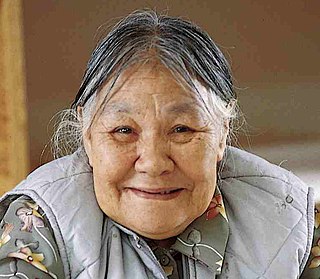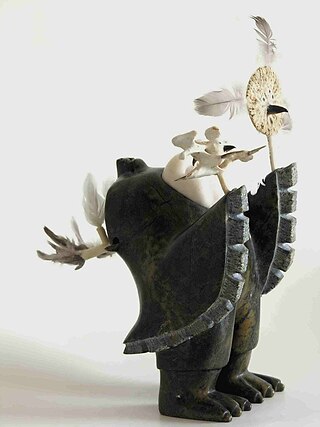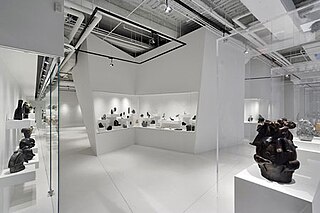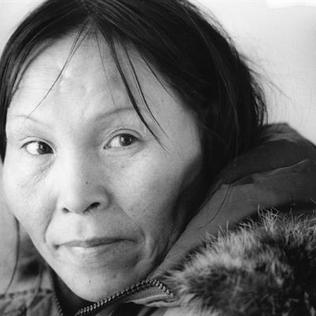
Kenojuak Ashevak,, is celebrated as a leading figure of modern Inuit art.

James Archibald Houston was a Canadian artist, designer, children's author and filmmaker who played an important role in the recognition of Inuit art and introduced printmaking to the Inuit. The Inuit named him Saumik, which means "the left-handed one".

Kinngait, formerly known as Cape Dorset until 27 February 2020, is an Inuit hamlet located on Dorset Island near Foxe Peninsula at the southern tip of Baffin Island in the Qikiqtaaluk Region of Nunavut, Canada.

Inuit art, also known as Eskimo art, refers to artwork produced by Inuit, that is, the people of the Arctic previously known as Eskimos, a term that is now often considered offensive. Historically, their preferred medium was walrus ivory, but since the establishment of southern markets for Inuit art in 1945, prints and figurative works carved in relatively soft stone such as soapstone, serpentinite, or argillite have also become popular.

Pudlo Pudlat (Pudlo), was a Canadian Inuit artist whose preferred medium was a combination of acrylic wash and coloured pencils. His works are in the collections of most Canadian museums. At his death in 1992, Pudlo left a body of work that included more than 4000 drawings and 200 prints.

The Museum of Inuit Art, also known as MIA, was a museum in Toronto, Ontario, Canada located within the Queen's Quay Terminal at the Harbourfront Centre. It was devoted exclusively to Inuit art and culture.

Kananginak Pootoogook was an Inuk sculptor and printmaker who lived in Cape Dorset, Nunavut, in Canada. He died as a result of complications related to surgery for lung cancer.
Parr was an Inuit artist. He lived a traditional Inuit lifestyle until 1961, when he settled in Cape Dorset because of declining health and a hunting accident.
Pitaloosie Saila was a Canadian Inuk graphic artist who predominantly made drawings and lithograph prints. Saila's work often explores themes such as family, shamanism, birds, and her personal life experiences as an Inuk woman. Her work has been displayed in over 150 exhibitions nationally and internationally, such as in the acclaimed Isumavut exhibition called "The Artistic Expression of Nine Cape Dorset Women". In 2004, Pitaloosie Saila and her well-known husband and sculptor Pauta Saila were both inducted into the Royal Canadian Academy of Arts.

Napachie Pootoogook was a Canadian Inuit graphic artist.

Ulayu Pingwartok was a Canadian Inuk artist known for drawings of domestic scenes and nature.
Alashua Aningmiuq (1914–1972) was an Inuit graphic artist and a carver in Nunavut, Canada working in the 1950s and 1960s.

Uqqurmiut Centre for Arts & Crafts is an arts centre that was established by the Uqqurmiut Inuit Artists Association in 1990, in Pangnirtung, in the Qikiqtaaluk Region of Nunavut, Canada. The Centre includes a Tapestry Studio, a Craft Gallery, and Print Shop. In spite of its remote location and small population, numerous Inuit from Pangnirtung have successfully marketed their prints, carvings, sculptures, and textile arts, such as woven wall hangings, to southern collectors. Starting in the 1970s, limited edition prints from the original Print Shop were published annually as the Pangnirtung Prints Collection through the then-Eskimo Co-operative. In 1970 a weaving studio was established and over time the tapestries attracted an international market.
Ikayukta Tunnillie was an Inuit artist in the fields of printmaking and drawing. Tunnillie was born in Nunavut and traveled for much of her life. Tunnillie's work in drawing and printmaking focused on animals and life in the North. She was one of the oldest printmakers to work with the West Baffin Eskimo Co-operative.
Kiugak Ashoona was a Canadian Inuk artist renowned for his sculptural work and his expansive artistic portfolio. He experienced the longest career of any Cape Dorset artist, and is a member of the Order of Canada and the Royal Canadian Academy of Arts. In 1999, he was awarded the Canada Council Molson Prize for his outstanding lifetime contribution to the cultural and intellectual life of Canada.
Innukjuakju Pudlat (1913–1972), alternatively known as Inukjurakju, Innukjuakjuk, Inujurakju, Innukjuakjuk Pudlat, Inukjurakju Pudlat, Innukyuarakjuke Pudlat, or Innukjuarakjuke Pudlat, was an Inuk artist who worked primarily in drawing and printmaking. During her artistic career she worked with the West Baffin Eskimo Co-operative in Cape Dorset, Nunavut.
The West Baffin Eskimo Cooperative, also known as the Kinngait Co-operative is an Inuit co-operative in Kinngait, Nunavut best known for its activities in buying, producing and selling Inuit artworks. The co-operative is part of Arctic Co-operatives Limited, a group of locally owned businesses that provide fundamental services in the Canadian north. The co-operative sets prices for the sale of its member's works, pays the artists in advance and shares its profits with its members.

Kiakshuk was a Canadian Inuit artist who worked both in sculpture and printmaking. Kiakshuk began printmaking in his seventies and, is most commonly praised for creating “real Eskimo pictures” that relate traditional Inuit life and mythology.
Eegyvudluk Pootoogook (1931-2000) was an Inuk printmaker and sculptor. He was married to the artist Napachie Pootoogook.
The Blind Man and the Loon, also commonly known as the Lumaaq Story, among other names, is a folktale told all over Greenland, Canada, and down into parts of the United States, though most heavily Inuit and Athabaskan.












